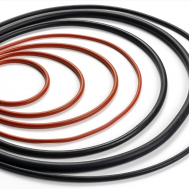Even though we’re always working on new things at Apple Rubber, it’s nice to take a brief break and reflect on our accomplishments. Those following us over the years may know about our manufacturing process for large o-rings and seals called thermobonding, which also helps provide excellent flexibility in our MacrOring® seals, and how our process differs from cold bonds.
But if you don’t know (and even if you do), here’s a refresher on our longstanding, unique thermobonding process, MacrOring seals, and how we differentiate from the cold bond process.
The Thermobonding Process
Thermobonding is Apple Rubber’s manufacturing method for our largest o-ring seals (MacrOring seals). This process involves splicing, where we cut the material to size and then apply non-cured adhesive to the ends. After splicing, the vulcanizer uses heat and pressure to cure and seal the ring. We mold the joint with our proprietary adhesiveness and cures with little to no mismatch, so the MacrOring seals have improved strength, tighter tolerances, and excellent flexibility.
The high level of quality that we are known for is inherent in the thermobonding process. Our technology serves a range of sizes, from 2” I.D. to 500” I.D. and more. Cross sections can span from .070” to 1”. Custom-engineered seals can meet specific performance requirements, with quick prototyping and sample production capabilities available within a 24-hour window.
We perform two key inspections (cord inspection and complete part inspection) on MacrOring seals to ensure compliance with our strict process control. Our cord inspection process involves full acceptance testing on all cord pre-use. This testing includes collecting samples of density, tensile, elongation, durometer, and cross-sectional measurement. Together with our complete part inspection quality assurance testing, we have the thermobonding process down to a science.
The Difference of MacrOring Seals to Cold Bonds
We created MacrOring seals as a superior, economical choice to accommodate growing market needs for larger and stronger o-rings with tighter tolerances than regular glue and slash seals. MacrOring seals can be applied where large o-rings are used, such as in maritime environments, gears and pistons of the automobile industry, heavy agricultural machinery, and an industrial power plant.
MacrOring seals can help you save costs in production runs. For example, they can be produced on demand to avoid potential production delays and delivery issues, so costly tooling and material waste typical of traditionally molded seals can be avoided. MacrOring seals are available in silicone, nitrile, neoprene, flurosilicone, flurocarbon, and neoprene sponge.
If you’re contemplating cold bonds, it’s important to know that, unlike thermobonding, they are not vulcanized, as they need to dry. Another thing to consider is that even though many cold bond adhesives can hold well enough, there is less flexibility, so it might not fit as well. Cold bonds can be seen as more of a stopgap when problems arise in the field.
Contact us if you’re interested in taking advantage of our thermobonding process, or if you want to know more about our MacrOring seals.
